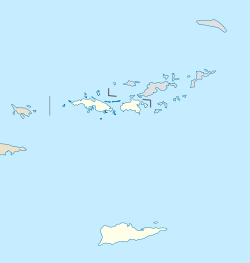Tutu | |
|---|---|
Subdistrict | |
 | |
Location within the United States Virgin Islands | |
| Coordinates: 18°20′N64°53′W / 18.333°N 64.883°W | |
| Country | |
| Territory | |
| District | Saint Thomas |
| Population (2010) | |
• Total | 6,867 |
| Area code | 340 |
Tutu, also known as Estate Tutu [1] is one of the seven administrative subdistricts on Saint Thomas island in the United States Virgin Islands. It is located in eastern St. Thomas and is mostly made up of the second-largest town or census-designated place (CDP) in the U.S.V.I., Anna's Retreat in the Tutu Valley, sometimes nicknamed Tutu. The word tutu, in Danish, means a trumpet-like conch shell which was used to call the slaves to work. [2] [3] According to the U.S. Census Bureau in 2010 the population was 6,867, which is down from 8,197 in 2000 and further down from 9,100 in the U.S. Census of 1990. Tutu is known as a densely populated residential area [4] [5] and is second only to the territorial historical capital of Charlotte Amalie in terms of highest population density on the island of Saint Thomas. It is home to approximately 20 percent of the island population and has a total area of 1.5 square miles. [6] There have been numerous excavations in an area known as the Tutu Archaeological Village Site, which has discovered numerous artifacts from the native Arawak people who inhabited the area in the pre-Columbian era. [7] [8]
